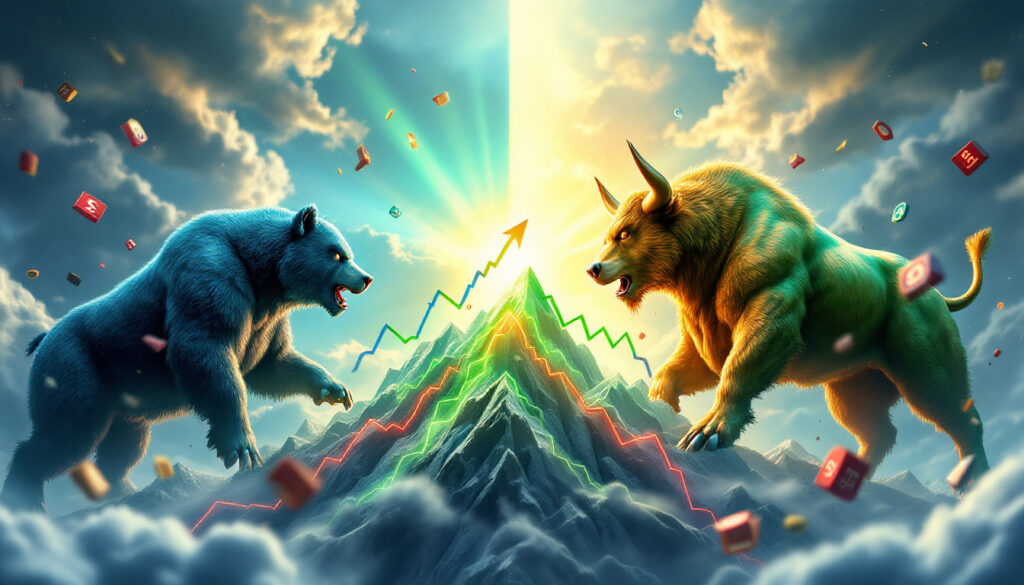What Is a Bull Market?
A bull market represents a period when share prices are rising and investor sentiment is optimistic. These extended periods of market strength are characterized by sustained upward price movements and growing investor confidence. Technically defined as a 20% rise from the 52-week low, bull markets signal economic expansion and opportunity.
Key Characteristics of Bull Markets
- Markets have risen by 20% or more from the 52-week high, measured using closing prices of major indices like the S&P 500
- Economy typically demonstrates strength with GDP growth averaging 2-3% annually
- Unemployment rates historically drop below 5% (as evidenced by the 3.5% U.S. unemployment rate in 2019)
- Investor confidence is high, encouraging further buying through a positive feedback loop
- "Bullish" market sentiment indicates more buyers than sellers, driving prices upward
"Bull markets are born on pessimism, grow on skepticism, and die on euphoria," as legendary investor Sir John Templeton noted, highlighting the psychological progression that underpins these market cycles.
How to Identify a Bull Market
- Sustained upward price movements across major indices over multiple months
- Increasing trading volumes specifically on upward price movements
- Strong corporate earnings reports exceeding analyst expectations
- Positive economic indicators (GDP growth, consumer spending, manufacturing expansion)
- Expansionary monetary policies from central banks, such as the near-zero interest rates implemented post-2008
The post-2009 bull market stands as a remarkable example, lasting over 11 years—the longest in history—with an average annualized return of 16%. More recently, the 2020-2021 rally saw the S&P 500 surge 68% following COVID-19 vaccine rollouts, with technology stocks like Apple gaining more than 120%.
What Is a Bear Market?
A bear market is essentially the opposite of a bull market, characterized by falling prices and negative sentiment. These challenging periods test investor resolve and often create opportunities for those with long-term perspectives.
Key Characteristics of Bear Markets
- Markets have fallen by 20% or more from the 52-week high, with declines averaging 34%
- Bear markets typically last around 14 months (the 2008 financial crisis lasted 17 months with a 54% S&P decline)
- Investor pessimism dominates market sentiment, leading to widespread selling
- Declining prices often create a negative feedback loop as investors seek to avoid further losses
- "Bearish" market sentiment indicates more sellers than buyers, pushing prices lower
- Coincides with economic slowdowns or recessions approximately 70% of the time
As J.P. Morgan famously stated, "In bear markets, stocks return to their rightful owners," highlighting how market downturns often separate speculative investors from those with conviction.
How to Identify a Bear Market
- Sustained downward price movements across major indices over multiple months
- Increasing trading volumes specifically during market declines
- Weakening corporate earnings and profit warnings becoming more frequent
- Negative economic indicators (rising unemployment, slowing growth, manufacturing contraction)
- Defensive sectors (utilities, consumer staples, healthcare) outperforming growth sectors
- Technical indicators like "death crosses" (50-day moving average falling below 200-day moving average) as seen during the 2020 COVID crash
The 2022 bear market, which saw the S&P 500 decline by approximately 25%, was triggered by Federal Reserve rate hikes and energy supply shocks following the Russia-Ukraine conflict—demonstrating how both monetary policy and geopolitical factors can initiate market downturns.
What's the Difference Between a Market Correction and a Bear Market?
Market corrections and bear markets are distinguished primarily by their magnitude, duration, and broader economic implications. Understanding market dynamics helps investors respond appropriately to market movements.
Market Correction Characteristics
- Price declines of 10-20% from recent highs, stopping short of the bear market threshold
- Typically temporary price reversals occurring on average every 11 months since 1950
- Often resolve within approximately 4 months, compared to the longer recovery periods for bears
- Usually followed by continued upward market movement as prices "correct" to more reasonable valuations
- Can occur within an overall bull market without disrupting the long-term uptrend
"Corrections are like thunderstorms—they clear the air," as renowned investor Peter Lynch observed, suggesting these temporary setbacks can actually create healthier market conditions.
Bear Market vs. Correction Comparison
| Feature | Market Correction | Bear Market |
|---|---|---|
| Magnitude | 10-20% decline | 20%+ decline |
| Duration | Typically 2-4 months | Often 12+ months |
| Recovery | Usually quicker (months) | Typically slower (years) |
| Economic Impact | Limited | Often substantial |
| Investor Sentiment | Cautious | Pessimistic |
| VIX "Fear Index" | Spikes to 30+ temporarily | Sustained readings above 30 |
| Recovery Returns | Averages 23% in 12 months | Can exceed 50%+ but takes longer |
The 2018 Q4 correction provides an instructive example, with markets declining by nearly 19.8% before recovering after the Federal Reserve paused its interest rate hiking cycle. This contrasts sharply with true bear markets like 2008, which required years for full recovery.
How Do Bull and Bear Markets Affect Investment Strategies?
Different market conditions call for different investment approaches. Savvy investors adjust their strategies to align with the prevailing market environment while maintaining core principles.
Bull Market Investment Strategies
- Growth-oriented investments often outperform, with data showing technology and consumer discretionary sectors leading (Tesla gained 720% from 2019-2021)
- Higher allocation to equities may be appropriate as markets trend upward
- Momentum strategies can be effective during strong bull phases
- Focus on sectors benefiting from economic expansion (financials, industrials, technology)
- Consider gradually taking profits as the bull market matures, following Warren Buffett's advice to "be fearful when others are greedy"
Many successful investors use bull markets to build positions in quality companies while remaining vigilant for signs of excessive optimism. Maintaining discipline becomes increasingly important as bull markets extend into later stages.
Bear Market Investment Strategies
- Defensive sectors tend to outperform, historically declining 15% less than broader markets
- Increased allocation to fixed income may reduce portfolio volatility
- Value investing approaches may identify undervalued opportunities amid market fear
- Dollar-cost averaging can take advantage of lower prices over time
- Risk management becomes increasingly important, with stop-loss orders and portfolio hedging
- Dividend aristocrats like Procter & Gamble provided yields exceeding 4% during 2008-2009
Ray Dalio's "All Weather Portfolio," which advocates 40% allocation to long-term bonds during bear markets, represents one systematic, data-driven investment approach to navigating downturns. Tax-loss harvesting can also reduce capital gains liabilities by offsetting up to $3,000 annually against ordinary income.
What Causes Bull and Bear Markets?
Understanding the drivers behind market cycles can help investors anticipate changes and position themselves accordingly. Both macroeconomic factors and market psychology play critical roles.
Common Bull Market Catalysts
- Strong economic growth and expanding corporate earnings
- Accommodative monetary policies, with S&P 500 P/E ratios expanding when Fed funds rates remain below 3%
- Technological innovations and productivity improvements driving new economic opportunities
- Favorable regulatory environments encouraging business expansion
- Positive investor psychology and market sentiment creating self-reinforcing cycles
- Substantial fiscal stimulus, as seen with the $5 trillion global stimulus that fueled the 2020 bull market
Howard Marks, co-founder of Oaktree Capital, observes that "bull markets require liquidity; bears need catalysts"—highlighting how ample monetary support often underpins extended market rallies.
Common Bear Market Triggers
- Economic recessions or slowdowns, with 70% of bear markets following two or more quarters of declining earnings
- Rising interest rates and tightening monetary policy (S&P 500 P/E ratios contract approximately 20% when Fed funds rates exceed 5%)
- Geopolitical crises or significant global events disrupting supply chains or energy markets
- Market bubbles reaching unsustainable levels, often signaled by the Buffett Indicator (market cap/GDP) exceeding 140%
- Negative investor psychology and panic selling creating downward spirals
- Quantitative tightening, as demonstrated by the $4 trillion contraction that contributed to the 2022 market decline
The 2022 bear market illustrates how multiple factors—Fed policy shifts, inflation concerns, and geopolitical tensions—can converge to change market direction after an extended bull run.
How Long Do Bull and Bear Markets Typically Last?
Historical patterns provide context for understanding market cycles, though each market environment has unique characteristics that affect duration and magnitude.
Bull Market Duration Patterns
- Historical bull markets have averaged 4.5 years since 1926, with cumulative returns averaging 267%
- The 2009-2020 bull market lasted over 11 years, becoming the longest in recorded history
- Bull markets often end with periods of excessive optimism, characterized by IPO frenzies or retail investor surges
- Longer bull markets don't necessarily produce higher annualized returns
- Economic fundamentals typically support sustainable bull markets, with those backed by earnings growth lasting longer than those driven purely by sentiment
The remarkable 2009-2020 bull market demonstrates how accommodative monetary policy, technological innovation, and corporate profitability can sustain upward market trends for extended periods.
Bear Market Duration Patterns
- Historical bear markets have lasted between 10 months to 3 years, with a median duration of 14 months
- The average bear market decline has been approximately 34% from peak to trough
- Bear markets often end with periods of extreme pessimism, presenting opportunities for contrarian investors
- Shorter, sharper bear markets typically occur during financial crises or external shocks
- Bear markets ending in recessions tend to last longer and decline further
- Recovery to previous peaks takes 3.1 years on average
The contrast between the 1973-1974 bear market, which took 7 years to recover fully, and the 2020 COVID-induced decline, which rebounded in just 5 months, illustrates the varying recovery patterns based on underlying economic conditions and policy responses.
How Can Investors Identify Bull and Bear Market Trends?
Recognizing market transitions helps investors adjust their strategies accordingly. Both technical indicators and fundamental factors can provide valuable signals.
Technical Indicators for Market Trends
- Moving averages (50-day, 200-day) crossing patterns signaling trend changes
- Market breadth indicators (advance/decline lines) showing participation breadth
- Relative strength indicators (RSI) showing momentum, with readings above 70 indicating overbought conditions and below 30 signaling oversold conditions
- Volume patterns during price movements confirming trend strength
- Sector rotation patterns indicating market sentiment shifts
- Fibonacci retracement levels (38%, 50%, 62%) helping predict potential rebound magnitudes
Advance-decline line divergences successfully flagged the approaching 2007 bear market, demonstrating how technical indicators can provide early warnings of changing market environments.
Fundamental Indicators for Market Trends
- Corporate earnings growth trajectories and forward guidance
- Interest rate environments and yield curve shapes, with inversions preceding 6 of 7 recessions since 1965
- Economic leading indicators (manufacturing PMI, housing starts, employment trends)
- Valuation metrics compared to historical averages (Shiller P/E, price-to-book)
- Central bank policy directions and changes in monetary stance
- The Buffett Indicator (market cap to GDP ratio) successfully signaled overvaluations before the 2000 and 2021 market peaks
Combining technical and fundamental approaches offers the most comprehensive perspective, as each methodology provides different insights into market dynamics and potential inflection points.
FAQ: Common Questions About Bull and Bear Markets
What's the origin of the bull and bear market terms?
The terms originate from the way these animals attack: bulls thrust upward with their horns, while bears swipe downward with their paws, symbolizing the direction of market movements. These terms date back to 18th-century London stockjobbers and have become universal shorthand for market directionality.
Can you have a bull market in specific sectors during a broader bear market?
Yes, sector-specific bull markets can occur during broader bear markets as investors rotate into defensive or counter-cyclical sectors. During the 2008 financial crisis, consumer staples and healthcare stocks significantly outperformed the broader market, with some companies even posting gains amid the general decline.
How should retirement investors approach bull and bear markets?
Retirement investors should maintain a long-term perspective, focusing on asset allocation appropriate for their time horizon rather than attempting to time market cycles. Research from Fidelity shows that maintaining investment discipline through market cycles significantly outperforms attempts at market timing, which often results in missing key recovery days.
What role do market cycles play in long-term investing?
Market cycles create opportunities for disciplined investors to buy quality assets at lower prices during bear markets and potentially reduce risk exposure during extended bull markets. The compound annual growth rate of major indices demonstrates that investing vs. speculating through cycles typically rewards patient investors despite periodic declines.
How do international markets correlate during bull and bear markets?
Global market correlation often increases during bear markets ("all correlations go to one in a crisis"), while bull markets may see more divergence based on regional economic conditions. The MSCI World Index shows correlation coefficients approaching 0.85 during crisis periods, compared to more moderate correlations during bull phases when country-specific factors exert greater influence.
Following timeless investing rules and understanding the difference between a bull and a bear market helps investors navigate different market conditions. Additionally, some investors turn to gold market analysis when traditional markets become volatile, as gold often serves as a hedge during bear markets.
Want to Spot the Next Major ASX Discovery Before the Market?
Discovery Alert's proprietary Discovery IQ model identifies significant mineral discoveries the moment they're announced on the ASX, giving subscribers a genuine market advantage. Explore historic discovery returns and see how our AI-powered alerts could help you capitalise on the next market-moving discovery at Discovery Alert's discoveries page.




